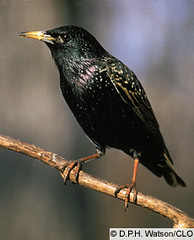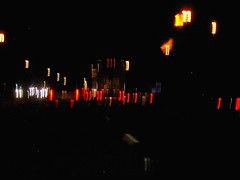some never leave
winter is seriously sad and i miss the garden, but the wonderful thing is that the european starlings are still singing their songs. european starlings are considered an invasive species and i can certainly see why: they take over the bird feeder; they bump the smaller birds off and hog the space for themselves, but in reality, it makes it easier for the smaller birds because they take advantage of the wasteful clumps of seeds that the starlings drop as they hastily and greedily monopolize the feeder.
i am not trying to draw an analogy between starlings and human behaviour because starlings are doing what they have to do. in a way they help the little birds, and i can always put out more seed.
what i love absurdly about the starlings, is that all of their songs are different: not only from group to group, but they go off for a little while and then they return with new songs that they learn from other bird species. they learn these new languages and playfully call back and forth; new songs every day. the ones in our backyard always sound like they are mimicking the car alarms with their intermittent and inconsistent sirens.
everyone hates the starlings, but they are adapting to their alienation. you can't blame them for what a bunch of looney romantics did because they wanted to make the world a more beautiful place (keep reading - it might make sense). it's mistakes like these that bring about evolution; but this is not to be confused with intentional harm - something found all too often in our world.
all i know is that the starlings stay steadfast through the winter. they keep me company until the garden comes back. (but i still see the hawk. it was hunting pigeons infront of st. cecilia's school the other day; i don't think it caught anyone).
but anyway, here is what the experts say about starlings:
Description
* Stocky, black bird.
* Short, square-tipped tail.
* Pointed, triangular wings.
* Long pointed bill, yellow in breeding season.
* Shimmering green and purple feathers in spring.
* Size: 20-23 cm (8-9 in)
* Wingspan: 31-40 cm (12-16 in)
* Weight: 60-96 g (2.12-3.39 ounces)
Sex Differences
Sexes similar.
Sound
Song is a rather quiet series of rattles and whistled notes, often containing mimicry of other bird species. Flight call a purring "prurrp." (jessa's note: this is total bull because they are loud and incessant; they are the most gossipy birds i have ever seen and they are definitely not quiet. it's probably because they have to compete with the noises of the city)
Conservation Status
Introduced into North America in the 1890s, the European Starling quickly spread across the continent. It is a fierce competitor for nest cavities, and frequently expels native bird species. It is believed to be responsible for a decline in native cavity-nesting bird populations, but a study in 2003 found few actual effects on populations of 27 native species. Only sapsuckers showed declines because of starlings, and other species appeared to be holding their own against the invaders.
Other Names
L'étourneau sansonnet (French)
Estornino pinto (Spanish)
Neat Facts
* All the European Starlings in North America descended from 100 birds released in New York's Central Park in the early 1890s. A group dedicated to introducing America to all the birds mentioned in Shakespeare's works set the birds free. Today, European Starlings range from Alaska to Florida and northern Mexico, and their population is estimated at over 200 million birds. (jessa's note: i know it's crazy, and it's so detrimental, but isn't there something terribly romantic about that...or maybe i mean terribly dimented. i am sorry, but i still haven't learned to appreciate shakespeare.)
* Although the sexes look very similar, they do show some subtle differences. The male tends to be larger, more iridescent, and have longer throat feathers, but some females can be larger, more glossy, and have longer feathers than some males. During breeding when they have yellow bills, the base of a male's lower mandible is blue-gray, while the female's is pinkish. The male's eyes are a uniform deep brown, but the female has a narrow, lighter colored ring around the outer edge. In confusing cases, some males four years old or older can develop a faint ring in the eye, and some older females can lose it.
* A female European Starling may try to lay an egg in the nest of another female. A female that tries this parasitic tactic often is one that could not get a mate early in the breeding season. The best females find mates and start laying early. The longer it takes to get started, the lower the probability of a nest's success. Those parasitic females may be trying to enhance their own breeding efforts during the time that they cannot breed on their own.
Sources used to construct this page:
1. Cabe, P. R. 1993. European Starling (Sturnus vulgaris). In The Birds of North America, No. 48 (A. Poole, and F. Gill, eds.). The Academy of Natural Sciences, Philadelphia, PA, and The American Ornithologists' Union, Washington, D.C.
2. Koenig, W. D. 2003. European Starlings and their effect on native cavity-nesting birds. Conservation Bioloy 17: 1134-1140.
3. Sandell, M. I., and M. Diemer. 1999. Intraspecific brood parasitism: a strategy for floating females in the European starling. Animal Behaviour 57: 197-202.
i am not trying to draw an analogy between starlings and human behaviour because starlings are doing what they have to do. in a way they help the little birds, and i can always put out more seed.
what i love absurdly about the starlings, is that all of their songs are different: not only from group to group, but they go off for a little while and then they return with new songs that they learn from other bird species. they learn these new languages and playfully call back and forth; new songs every day. the ones in our backyard always sound like they are mimicking the car alarms with their intermittent and inconsistent sirens.
everyone hates the starlings, but they are adapting to their alienation. you can't blame them for what a bunch of looney romantics did because they wanted to make the world a more beautiful place (keep reading - it might make sense). it's mistakes like these that bring about evolution; but this is not to be confused with intentional harm - something found all too often in our world.
all i know is that the starlings stay steadfast through the winter. they keep me company until the garden comes back. (but i still see the hawk. it was hunting pigeons infront of st. cecilia's school the other day; i don't think it caught anyone).
but anyway, here is what the experts say about starlings:
Description
* Stocky, black bird.
* Short, square-tipped tail.
* Pointed, triangular wings.
* Long pointed bill, yellow in breeding season.
* Shimmering green and purple feathers in spring.
* Size: 20-23 cm (8-9 in)
* Wingspan: 31-40 cm (12-16 in)
* Weight: 60-96 g (2.12-3.39 ounces)
Sex Differences
Sexes similar.
Sound
Song is a rather quiet series of rattles and whistled notes, often containing mimicry of other bird species. Flight call a purring "prurrp." (jessa's note: this is total bull because they are loud and incessant; they are the most gossipy birds i have ever seen and they are definitely not quiet. it's probably because they have to compete with the noises of the city)
Conservation Status
Introduced into North America in the 1890s, the European Starling quickly spread across the continent. It is a fierce competitor for nest cavities, and frequently expels native bird species. It is believed to be responsible for a decline in native cavity-nesting bird populations, but a study in 2003 found few actual effects on populations of 27 native species. Only sapsuckers showed declines because of starlings, and other species appeared to be holding their own against the invaders.
Other Names
L'étourneau sansonnet (French)
Estornino pinto (Spanish)
Neat Facts
* All the European Starlings in North America descended from 100 birds released in New York's Central Park in the early 1890s. A group dedicated to introducing America to all the birds mentioned in Shakespeare's works set the birds free. Today, European Starlings range from Alaska to Florida and northern Mexico, and their population is estimated at over 200 million birds. (jessa's note: i know it's crazy, and it's so detrimental, but isn't there something terribly romantic about that...or maybe i mean terribly dimented. i am sorry, but i still haven't learned to appreciate shakespeare.)
* Although the sexes look very similar, they do show some subtle differences. The male tends to be larger, more iridescent, and have longer throat feathers, but some females can be larger, more glossy, and have longer feathers than some males. During breeding when they have yellow bills, the base of a male's lower mandible is blue-gray, while the female's is pinkish. The male's eyes are a uniform deep brown, but the female has a narrow, lighter colored ring around the outer edge. In confusing cases, some males four years old or older can develop a faint ring in the eye, and some older females can lose it.
* A female European Starling may try to lay an egg in the nest of another female. A female that tries this parasitic tactic often is one that could not get a mate early in the breeding season. The best females find mates and start laying early. The longer it takes to get started, the lower the probability of a nest's success. Those parasitic females may be trying to enhance their own breeding efforts during the time that they cannot breed on their own.
Sources used to construct this page:
1. Cabe, P. R. 1993. European Starling (Sturnus vulgaris). In The Birds of North America, No. 48 (A. Poole, and F. Gill, eds.). The Academy of Natural Sciences, Philadelphia, PA, and The American Ornithologists' Union, Washington, D.C.
2. Koenig, W. D. 2003. European Starlings and their effect on native cavity-nesting birds. Conservation Bioloy 17: 1134-1140.
3. Sandell, M. I., and M. Diemer. 1999. Intraspecific brood parasitism: a strategy for floating females in the European starling. Animal Behaviour 57: 197-202.










5 Comments:
yeah, the hawks really don't like all the commotion, but i am sure all of the pigeons are pretty tempting.
but considering that it's only a ten minute walk to high park from annette, it's probably a pretty short fly. their territory is probably gigantic and there must only be one or two maiting pairs around.
You guys are too cute. I can just see you both with binoculers around your necks when you're 70!
birds live in a totally different reality. it's pretty incredible. we just tend to think about species as heirarchical (no spell check on comments) and linear.
and i think everyone in the world should see the movie 'the parrots of telegraph hill' - i hope i got the title right.
thank you for the visit and especially the comment!
i'll make sure to post more birding news, although my birdfeeder is a little lonely at the moment. we just have one downy pair that seems to be the only two that can peck out the frozen seeds.
sounds like chris moonbeams has been chatting with spindrift
Post a Comment
<< Home